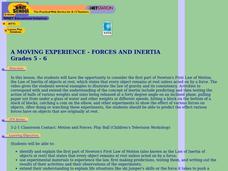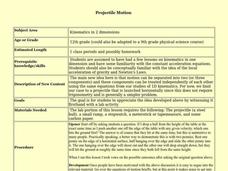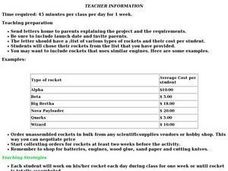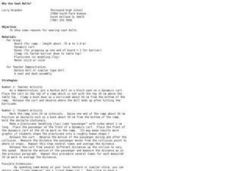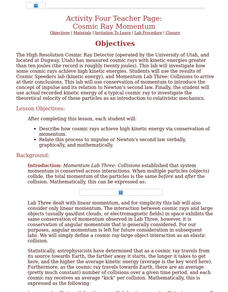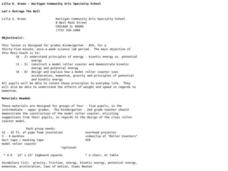Curated OER
The Inertial Balance
Students weigh objects using a triple beam balance. In this mass lesson, students use an inertial balance made with a metal rod to measure and graph vibrations of varying numbers of pennies in a bucket. References and discussion prompts...
Curated OER
A Moving Experience - Forces and Inertia
Students view a video and complete corresponding activities to observe inertia. They observe and predict the effect various forces have on objects.
Curated OER
Secondary Robot
Students identify the forces acting on a stationary/constant velocity robot. In this physics lesson, students draw a free body diagrams of the forces. They explain the difference between zero acceleration and zero net force.
Curated OER
Projectile Motion
Twelfth graders experiment with a projectile that is launched horizontally after a demonstration and small discussion about two pennies, one dropping from a table top and the other being slide off the top and hitting the ground at about...
Curated OER
Earth Turns? Prove It!
Students construct a pendulum using a washer and thin fishing line. In this earth science activity, students simulate Earth's rotation using the pendulum bob and swivel chair. They explain how this activity proves that the Earth is...
Curated OER
E3 Ret Lesson Plan
Students explore friction. In this physics lesson plan, students will cover metal blocks with film to determine the changes caused by static and kinetic friction.
Curated OER
Building and Launching Rocket Kits
Students, in groups, build and decorate rocket kits and then launch them.
Curated OER
Acceleration and You
Middle schoolers discuss and view examples of acceleration. They work together to determine acceleration rates in two ways. They analyze their data and discuss.
Curated OER
Why Use Seat Belts?
Students explore reasons why using a seat belt is a safe choice while riding in a car. In this physics/safety instructional activity, students set up and observe a doll with and without a seat belt moving down a ramp in a dynamics cart....
Curated OER
Challenger's Lost Lessons - The Lost Simple Machines Lesson
Students investigate the characteristics of simple machines. In this simple machine lesson, students investigate work as a product of applying constant force. They answer questions about what happens on Earth and what may have happened...
Curated OER
Learn to Build a Rocket in 5 Days or Your Money Back
Students discover the entire process that goes into designing a rocket for any customer. They study important factors such as supplies, ethics, deadlines and budgets. Also, students explore about the Engineering process, and recognize...
Curated OER
Cosmic Ray Momentum
Students describe how cosmic rays achieve high kinetic energy via conservation of momentum.
Curated OER
Rocket Me into Space
Fourth graders study the concept of thrust and how it propels rockets into space. They discover why airplanes cannot travel into space while considering the engineering techniques use in designing rockets. They look at how space...
Curated OER
Lab for Truss Design and Testing
Learners design and build their own truss. For this physics lesson, students calculate the forces and maximum load. They complete a full scale diagram of their design.
Curated OER
Rocket Science 101
Students explore the aspects of Newton's First and Third Laws of Motion as they conduct controlled rocketry experiments and analyze the Mars Mission in terms of the principles of rocketry.
Curated OER
What was Newton's Idea of Science?
Students form logical foundations for analysis of observations. They improve analytic reading abilities through practice. Students investigate the foundations of scientific thought processes and how to apply them.
Curated OER
Investigating Motion
Young scholars explore types of motion. In this motion experiment, students observe how objects move. Young scholars work in small groups to discover the laws of motion.
American Chemical Society
Joseph Priestley, Discoverer of Oxygen
Do you want to hear a joke about nitrogen and oxygen? NO. We all know there is oxygen in the air and that plants produce oxygen, but how was it discovered? Scholars read a handout, answer questions, and analyze material in the...
Curated OER
Gravity: A Relatively Heavy Subject
Young scholars examine planetary movement and its relation to the tide.In this gravity lesson students describe how and why the high and low tides change every day.
Curated OER
May the Force Be With You
Students work in groups, they investigate how different forces act upon objects and how this information can be used in their day-to-day lives. They wrap the rubber band around the book. Students place the bo.ok and ruler on top of a...
Curated OER
On the Shoulders of Giants
Learners select an astronomer or scientist from the past, research the role that they played in the development of the heliocentric revolution, and make presentations on their achievements.
Curated OER
Let's Outrage the Bull
Students study kinetic and potential energy. In this energy instructional activity, students in grades K-2 understand the differences between kinetic and potential energy. Students in grades 3-5 demonstrate that kinetic and potential...
Curated OER
Force and Motion
Students experiment with force and motion. In this force and motion instructional activity, students test gravity using a variety of objects. Students rotate through a series of stations which use force, motion, friction, and inclines....
Curated OER
The Physics of the Planets: How 16th and 17th Century Physicist Helped Us Understand Our Solar System
Eighth graders draw the paths of the planets in the solar system. In this astronomy lesson, 8th graders calculate speed of objects using distance and time information. They research about the work of scientists in the 16th and 17th century.
Other popular searches
- Newton, Isaac
- Sir Isaac Newton
- Isaac Newton Power Point
- Isaac Newton 2nd Law
- Isaac Newton and Gravity
- Isaac Newton Gravity
- Education of Isaac Newton
- Isaac Newton Research
- Isaac Newton Vocabulary
- Pics of Isaac Newton
- Pods of Isaac Newton
- Sir Isaac Newton Apples



